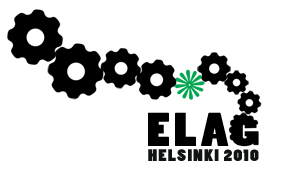Speaker
Mr
Till Kinstler
(Verbundzentrale des GBV)
Description
How to sort search results?
Who cares what's down the list, if the best results are on top?
When do users notice, we don't have anything matching their information needs?
Why not let users decide about the size of their result set?
[...]
And how do we find out?
We address these questions in a project called Suchkiste. We are building a discovery interface for a large and growing collection of digital scientific content licensed under the DFG Nationallizenzen funding programme[1]. One major project goal is providing good usefulness.
We drafted user experience requirements based on current literature, best practice examples and findings of similar projects (eg. Beluga[2]). Results of that process are four basic concepts well known by web users:
- one single, simple to use, but powerful search box as primary interaction tool
- "relevance ranking" of results
- tools that support browsing and filtering
- linkability: every page displayed must have a simple, persistent URL in the browser address bar
The actual user interface design was done in cooperation with consulting HCI experts of HTW Chur. We used focus groups to get qualified user feedback on the ideas we developed.
At project midterm in January 2010 we put the first public release of Suchkiste on the net. It holds about 22 million digital objects in a unified search index (consisting of metadata and full text) so far (growing as we get more data) and features the basic implementation of the user interface.
The user interface is based on a table showing a framed view of the data space in Suchkiste. By default the frame is filled with the 20 "best hits" matching a user's query (sorted by "relevance"). There is no pagination in the table. Record details are zoomable. So far, we provide only basic tools to filter and navigate results.
Depending on results of usability tests scheduled for spring 2010 we will decide how to improve the user experience. We are thinking about additional filtering tools (instead of traditional faceted navigation), personalization functionality based on our framed views concept, individualization of result ranking and ways to link up our discovery service with the web even better.
In my presentation at ELAG I will explain how and why our user interface concept differs from traditional OPACs, talk about limitations met while implementing it (for example imposed by data quality and web technology) and elaborate on ideas we consider for implementation.
[1] About Suchkiste:
Suchkiste (http://finden.nationallizenzen.de/) is developed by Verbundzentrale des GBV (VZG) in a three year low budget project that started in Summer 2008. Verbundzentrale des GBV is the technical service center of Gemeinsamer Bibliotheksverbund (GBV), the largest library consortium in Germany.
Suchkiste aims to provide easy access to the Nationallizenzen collections hosted across lots of different publisher web sites. It should serve as a single user friendly starting point for exploring this rich variety of scientific content. So far (January 2010) license agreements covering more than 150 million digital ressources have been sponsored. Some information in English on DFG Nationallizenzen is available at http://www.dfg.de/en/research_funding/programmes/infrastructure/lis/digital_information/library_licenses/index.html
Participating publishers are required to provide complete metadata about purchased content by Nationallizenzen license agreements. In a cumbersome workflow we analyze, convert, enrich and store that data in the central metadata management system of our library consortium (a OCLC CBS system). Some publishers deliver fulltext content as well. We provide access to that aggregated data pool through interfaces (Z39.50, SRU) and data download for entitled users (participants of Nationallizenzen). Suchkiste is one application using that data in a unified search index.
We evaluated different technical solutions and finally decided to use open source software to build Suchkiste, because the commercial options available do not meet our requirements in terms of customizability. We use Solr as index engine and VuFind as easily adoptable user frontend framework.
[2] Beluga is a project developing a next generation library catalogue that strongly uses methods of user centered design, http://beluga-blog.sub.uni-hamburg.de/
Author
Mr
Till Kinstler
(Verbundzentrale des GBV)
